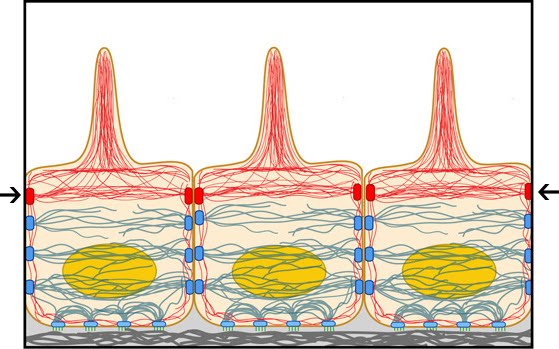Read Further…
Adherens Junctions facilitate cell-cell interactions
For information on where adherens junctions are located see: Dynamic Cytoskeleton
In polarized epithelial cells, the most obvious feature of the actin cytoskeleton is the contractile bundle of actin filaments usually located near the apical surface; this circumferential belt (aka adhesion belt) is linked from one cell to another through the extracellular domains of a continuous band of transmembrane molecules belonging to the cadherin family [4, 5], along with other anchoring proteins (e.g. catenins, vinculin, and α-actinin) [6, 7]. The actin and associated myosin are positioned to sense tension and to brace the cell [8, 9]. Contraction of the actin network also provides motile forces for tissue morphogenesis and cell migration [10, 11].
Figure: Adherens junctions link actin filaments between cells. This diagram specifically depicts adherens junctions (red rectangles) connecting actin filaments (red lines) across polarized epithelial cells. In these cells, this results in the formation of contractile bundles of actin and myosin filaments near the apical surface – this forms a structure called the adhesion belt (arrows). Other junctions termed desmosomes (large blue rectangles) and hemi-desmosomes (small blue rectangles) link intermediate filaments (blue lines) between cells.

